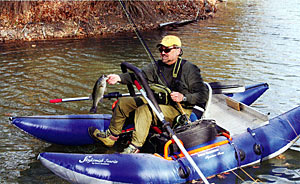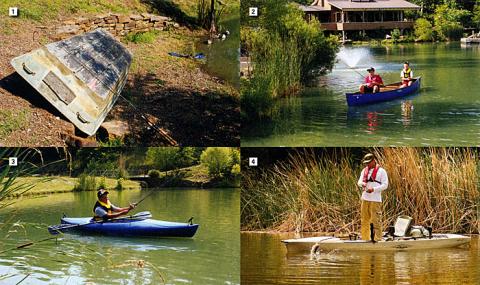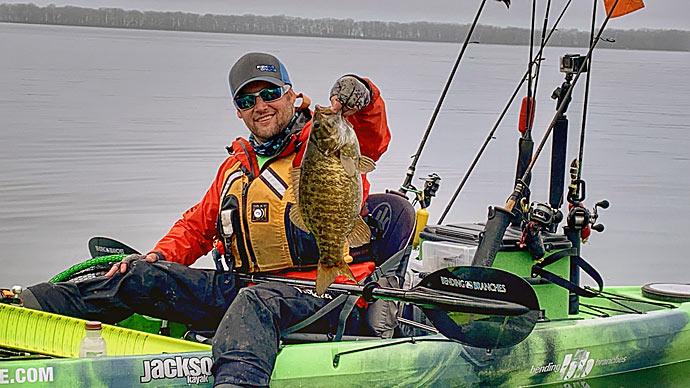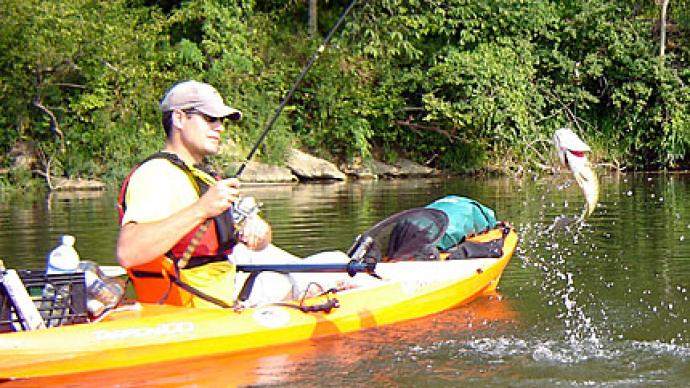
One of the best things about fishing ponds or small lakes is that you do not necessarily need a boat to fish them. A good number of ponds even have walking paths around them. Some ponds are so small that an angler can almost cast across. No boat is required for fishing these little ponds. Although anglers can walk around and cast from shore on larger ponds, the most efficient way of fishing these ponds is in a boat.
Good pond boats come in a variety of sizes and styles. These vessels vary from environmentally friendly self-propelled belly boats, inflatable pontoon boats, kayaks, and canoes to small electric-driven boats to motorized flat bottom boats and fancy bass boats. When fishing from them, all these boats have their advantages and disadvantages. For anglers stuck on shore, having a boat equals the opportunity to cast and catch fish in unreachable areas of the pond.
Environmentally Friendly Boats
Environmentally friendly or eco-friendly boats are extremely popular with pond owners. Boats without motors mean pond owners do not have to worry about outboard engines polluting water or hydrocarbon emissions that can impact the pond sediment and water column and gasoline spillage when refilling.. .or leaking from a gas tank.
Belly Boats
Belly boats or float tubes are inflatable U-shaped or round-shaped seats that float an angler in any water depth. Propulsion comes from the angler's feet. These devices are incredibly comfortable to fish from and especially popular with fly anglers. As far as mobility is concerned, no other boat can do what a belly boat can. They are incredibly lightweight, do not require a trailer, are low maintenance, and, when deflated, can easily be put in the trunk of a car and only require a small area for storage at home or lakeside. Unfortunately, some of the same attributes that make it great for pond fishing can also leave an angler wanting more. For instance, there is little tackle storage, and the number of rods you can take is limited. While you do not have to worry about tipping over, being close to the water's surface, this low profile can reduce casting distances and your ability to spot fish or underwater cover. Strong winds can cause mobility issues.
How expensive a belly boat depends on material and craftsmanship. A quality belly boat costs around $200 without optional equipment. Optional equipment for belly boats includes an electric or hand inflator, swim fins, rod holders, and storage bag.
Overall, belly boats are a great way to fish ponds. No other boat will put you closer to the action. Imagine the excitement of a big fish jumping next to you or pulling you around the pond.
Pontoon Boats
Portable pontoon boats are inflatable and similar to belly boats but have a welded aluminum frame where pontoons attach. Propulsion and steering come from the angler rowing. Unlike a belly boat, pontoon boats are comfortable and do not require the angler's complete lower body to be in the water. These small boats are designed to be rowed and can travel farther distances than a belly boat. Sitting higher allows more effortless casting and retrieval of snagged lures. Although relatively stable, an angler can tip over or fall off a pontoon boat. Another drawback is these single-seat pontoon boats are not made for anglers to stand up, so you have to sit when fishing. Strong winds can make moving around or fishing one spot difficult. As for storage, a pontoon boat can be deflated and taken apart, leaving the frame and deflated pontoons which require only a small area. Most single-seat pontoon boats weigh around 75 pounds and can handle weight up to 500 pounds of tackle and angler. Optional equipment for pontoon boats includes hand pump, electric/DC pump, anchor and rope, oar stops, oar tethers, seat saddlebag, rod holders, and fins.
Pontoon boats offer a good angle for casting and setting the hook and having more storage room for the tackle. A quality pontoon boat can cost around $1,300 without optional equipment. It's about as close as you can get to a boat without a trailer.
Kayaks and Canoes
Kayaks and canoes are gaining in popularity. They require little or no maintenance and can be stored beside the pond. Typically, a paddle supplies propulsion, but some kayaks now move by the angler peddling their feet; this allows hands-free fishing. The majority of kayaks are single-person crafts made of polyurethane. They sit low to the water's surface and take little effort to move from place to place. Unlike a paddle used for a canoe, a kayak paddle has a curved blade on both ends. Anglers can choose from either a sit-inside or sit-on-top model. The sit-inside offers more protection from the environment and provides interesting storage areas. A spray skirt is required to keep water from getting inside and keep an angler dry.
Unlike kayaks, canoes can easily accommodate two anglers with plenty of tackle and fishing rods. Canoes also sit higher out of the water than kayaks. Most canoes are now made out of polyurethane or aluminum. While most canoes are paddle-driven, a few are made with a transom for a small outboard engine for covering longer distances. A wide selection of optional equipment for kayaks and canoes includes livewells, padded seats, anchors, depth finders, rod holders, waterproof containers, cup holders, and repair kits. Paddles are the most expensive optional equipment, and it's worth it to purchase a high-quality paddle.
Both kayaks and canoes are excellent choices for fishing shallow water and thick vegetation; however, strong winds can make fishing tough. The biggest drawback is tipping over and losing all your fishing tackle. It's a wise investment to stow your gear in containers that can float. After gaining paddling experience, anglers will find tipping less of an issue. The cost can range from $350 to over $1,800 on premium kayaks and canoes. Inexpensive inflatable ones are also available.
Kayaks and canoes can easily be transported in the bed of a truck or on top of vehicles.
Flat Bottom or Hybrid Electric Boats
Flat bottom or hybrid electric boats are larger and can comfortably handle one or two anglers. A flat bottom is usually powered by an outboard engine to quickly drive to the area where an angler plans to fish, and then an electric trolling motor is used to slow the pace for better fishing. Flat bottom boats come in various sizes, but most are stable and comfortable. Unlike kayaks and canoes, flat-bottom boats are mostly metal and known for being noisy if anglers move around in them.
Hybrid electric boats are small, stable, can be stored next to the pond, and handle one or two persons with gear. The trolling motor that propels them can be hand- or foot-operated; anglers generally prefer foot-operated to keep hands free for casting. These boats are perfect for fishing in ponds and lakes. They are eco-friendly and only require that the angler charge the battery before using them. Under normal conditions, the battery will last around six to eight hours before needing a charge. These boats are easy to transport in the bed of a truck or on a small trailer. The average two-man hybrid electric boat weighs 175 pounds and measures 10' by 48". The total weight capacity is approximately 575 pounds. The average cost is around $2000 for a good quality electric boat.
Bass Boat
Depending on pond size, an angler may be able to launch and fish out of a bass boat. Launching and pulling out is typically the most significant issue using a bass boat on a pond. Most bass boats utilize outboard gasoline motors and trolling motors on the bow. However, some bass boats can be propelled by larger, eco-friendly electric motors on the back. Bass boats are stable and can handle plenty of fishing tackle. In windy conditions, bass boats can maneuver easily into the wind and hold where the fish are biting.
PFD
When operating a boat on your pond, anglers should never overlook the importance of wearing a Personal Floatation Device (PFD). PFDs should be Coast Guard approved and properly fit. There are several styles to choose from, including PFDs for fishing in belly boats, kayaks, canoes, and all boats. Popular styles for anglers range from inflatable PFDs that activate when an angler falls in the pond to a fishing vest that allows for freedom of movement when casting and catching fish.
Part of the joy of owning a pond or getting to fish in someone's pond is the ability to move around the pond and access different areas. Pond boats give the angler an advantage of mobility, accessibility and can help anglers catch more.
Reprinted with permission from Pond Boss Magazine





